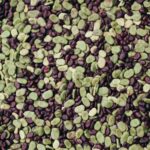Growing common beans is like opening a treasure chest: with the right care and guidance, you can uncover a bounty of flavorful, nutrient-packed gifts! Whether you’re an experienced gardener or just starting out, this guide will provide you with all the tips and tricks to successfully grow and care for common beans.
Let’s explore how to get your garden off to a running start. To start, it’s important to choose the right soil – one that drains well while still providing plenty of moisture. A quality fertilizer will also ensure your plants get the nutrients they need for growth. But don’t worry – it’s not rocket science! With our simple instructions, we’ll have you growing green beans in no time.
Once your plants are established, there are several other steps you can take to keep them healthy and maximize their yield. We’ll walk you through everything from pruning techniques to pest management so that every harvest is bountiful! So don’t wait any longer – follow us on this journey into the world of common bean cultivation and reap the rewards!
Choosing The Right Bean Variety
What type of bean is right for your garden? It’s a big decision. One that could make or break the success of your crop. With so many varieties to choose from, it can be overwhelming. But fear not! The perfect bean variety is out there waiting for you – and with our help, you’ll be able to find it in no time.
When selecting a bean variety, the most important factor to consider is your climate and soil conditions. Beans require warm temperatures and rich soil in order to grow to their full potential. Therefore, choosing a variety that is suitable for these conditions is crucial for successful harvests. Heirloom beans are particularly popular as they often thrive in different climates and soil types.
Other factors such as taste and texture preference should also play a role when selecting a bean variety. From crunchy French green beans to tender yellow wax beans – each one has its own unique flavor profile which makes them delicious additions to any meal! So take some time to explore all the options available before making your final decision – you won’t regret it!
Now that you’ve chosen the perfect bean variety, it’s time to get started on preparing the soil for planting...
Preparing The Soil For Planting
Oh boy, if there’s one thing more important than the variety of beans you choose to grow, it’s preparing the soil for planting them! Without properly preparing the soil, your beans won’t get that optimal start they need to grow and produce a good harvest. So, let’s dive deep into this crucial step in growing common beans.
First off, it’s all about making sure the soil is ready. You’ll want to make sure that it has the right texture and composition for your chosen variety of bean. Here are some of the key things you should do: -Test and adjust soil pH levels so that they are within range for your particular variety -Till or spade up the soil to incorporate compost or other organic matter -Add fertilizer tailored for your bean type -Ensure good drainage and aeration by using raised beds or mounds when necessary.
Not only will these steps help give your beans a great foundation on which to thrive, but they also have an added bonus: healthy soil means fewer issues with pests and disease! And while it might seem like a lot of work now, trust us – when you harvest those delicious green beans later on, you’ll be glad you put in all this effort!
Planting Green Beans
The early bird gets the worm.” This old adage applies to planting green beans as well. Planting green beans at the right time is essential to successful yields. It’s important to understand the basics of planting green beans for best results.
To start, prepare your soil by tilling it to allow for easy root growth and drainage. You’ll also need a trellis or other support structure for the bean plants, as they can grow up to 5 feet tall! Once you have your soil prepared, you’re ready to plant your green beans.
When planting, use your finger or a trowel to create small holes in the soil about an inch deep and 4 inches apart. Then drop two seeds into each hole – this will increase your chances of success since not every seed may germinate. Cover with soil, tamp down gently and water lightly with a spray bottle or watering can.
Now that you’ve planted your green beans, it’s time to turn our attention towards watering them properly so they stay healthy and happy! Making sure green beans are consistently hydrated helps promote strong growth and keeps them free from disease-causing organisms. With proper attention given during this critical step, you should be able to enjoy a productive harvest!
Watering Green Beans
It is often believed that watering plants can be just as important as planting them – that the two processes go hand in hand. But while it’s true that all plants need water, the key to successful growth lies in the timing and amount of water you give them. This is especially true when growing green beans. With the right technique, you can ensure your common beans will thrive and flourish.
When watering your green beans, it’s important to find a balance between too much and too little. Overwatering can lead to issues like root rot and stunted growth, while underwatering can cause wilting or yellowing of leaves. Since common beans grow best in soils with plenty of organic matter, aim for a regular schedule of twice-weekly light waterings rather than infrequent deep soakings.
For best results, use a soaker hose or drip irrigation system to apply the water directly to the soil around each plant rather than sprinkling from above. This keeps the foliage dry and helps prevent diseases like powdery mildew from taking hold. In addition, avoid wetting the foliage during midday when temperatures are hottest; this could actually burn your plants! With these tips in mind, you should have no problem keeping your green beans hydrated so they continue to grow healthy and strong.
Fertilizing Green Beans
Fertilizing green beans is an important part of their growth and production. Not only does it provide the plants with the nutrients they need to thrive, but it also helps to protect them from disease and pests. With so much to gain from fertilizing your green bean plants, it’s important that you know how to do it properly.
When it comes to fertilizing green beans, timing is key. The best time to fertilize is early in the season when the plants are just beginning to establish themselves. A slow-release fertilizer or a liquid fertilizer can be applied directly to the soil at this time. It’s important to not overdo it, however – too much fertilizer can burn your plants and cause stunted growth or even death.
Be sure to follow the instructions on the fertilizer package closely and pay attention to any warning labels that may be attached. Also, keep in mind that green beans don’t need a lot of extra nutrients during their growing season – a light application of fertilizer every few weeks should suffice. With proper care and attention, you can ensure that your green bean plants have everything they need for healthy growth and production throughout the season!
Regular fertilization helps keep your green bean garden healthy while also controlling weeds. As weeds compete with your green bean plants for resources such as sunlight, water, and nutrients, regular weed control is essential for producing strong yields of delicious green beans!
Controlling Weeds In Green Bean Gardens
Weeds are like the pests of a garden – they come in uninvited, take over and disrupt the natural order. In order to keep your green bean garden flourishing, it’s important to keep weeds under control. But how do you go about doing that?
One effective way is by using a physical barrier such as landscape fabric or mulch. This will help prevent weed seeds from germinating in your garden. Additionally, regularly hand-weeding any existing weeds will also ensure they don’t spread and choke out the healthy green beans.
Finally, keeping an eye on your soil moisture levels can also be helpful. If the soil is too dry, weeds are more likely to sprout – so make sure to water your bean plants regularly! By taking these simple steps, you can help protect your green bean garden from pesky weeds and ensure it stays healthy and productive for many years to come.
Controlling Pests In Green Bean Gardens
Though pests can be a major issue for growing green beans, there is hope. According to the USDA, only one in four gardeners report significant pest problems. With proper care and prevention techniques, you can keep your garden safe from pests and have a great harvest.
Prevention is key. Before planting, inspect the area for any signs of pest infestation. If you find any, apply an appropriate pesticide or natural remedy before planting your seeds or seedlings. Additionally, make sure to rotate crops every season to avoid re-infestation of pests in the same area year after year.
Next, take steps to make your garden less attractive to pests by removing weeds where possible and providing adequate air circulation around plants. You can also discourage pests by using companion plants like garlic or marigolds near green bean plants as their scents may repel certain insects. If a problem does occur, use an insecticidal soap or neem oil solution to get rid of bugs without damaging the plant’s leaves or fruit.
In addition to these preventative methods, you should also regularly check your green bean plants for signs of pests such as holes in leaves, webs on stems and flowers, and wilting leaves caused by sucking insects like aphids or caterpillars. Taking swift action at the first sign of trouble can help keep your garden healthy and free from damage caused by bugs. With these tips in mind, you’re well on your way to harvesting a plentiful crop of green beans!
Harvesting Green Beans
Harvesting green beans is one of the most rewarding parts of gardening. The key to harvesting beans is to pick them when they are young and tender, as they can quickly become tough and fibrous if left too long on the vines. To harvest, gently pull the bean off the vine or clip it with scissors. It is best to pick beans in the morning when they are still crisp and full of flavor.
Beans should be harvested often as this will encourage more production from the plant. If you harvest a few every day, you can extend your harvest for up to 6 weeks! At the end of the season, you may need to remove any remaining pods from the vine and discard them in order to discourage further growth.
Once you have harvested your green beans, it’s important to use them right away for maximum flavor and nutrition. You can store them in an airtight container in your refrigerator for up to 3 days or blanch and freeze them for later use.
TIP: Green beans are perfect for eating raw or lightly cooked. Try adding some freshly picked beans into salads or stir-fries for a delicious flavor boost!
Common Problems With Green Beans
Growing your own beans is a great way to have access to fresh, flavorful vegetables in your diet. But as with any crop, there are some common problems that can arise when growing green beans. This article will discuss some of the most common issues and how to address them.
The first issue is pests. Green beans are prone to aphids, caterpillars, and other bugs that can suck the life out of your plants before they’re even able to produce any pods. To combat this, make sure you inspect your plants regularly and remove any affected leaves or stems immediately. You can also set up traps or use natural insecticides like neem oil spray or diatomaceous earth.
Another issue is inadequate drainage in the soil. Poor drainage often leads to root rot which can cause stunted growth and discolored leaves. To avoid this problem, ensure that the soil you’re using has good drainage by adding compost or sand if necessary. Additionally, it’s important to water your plants properly; too much water will saturate the soil and could lead to root rot while too little water could cause wilting or dryness.
Taking these steps will help you get on your way to a successful harvest of tasty green beans! While it might take a bit of effort to troubleshoot any issues that arise during the growing process, with patience and diligence you’ll be able to enjoy a bountiful harvest for years to come. As for storing and freezing green beans, we’ll cover that next!
Storing And Freezing Green Beans
Storing and freezing green beans: it’s the best way to savor their flavor for longer. Juxtapose that with the fact that having fresh beans right off the vine is a dream-come-true for any gardener. But if you want to make sure your harvest lasts through the winter, storing and freezing them is key.
The first step in preserving green beans is to wash them thoroughly. This will ensure they don’t spoil as quickly once stored due to bacteria or other contaminants. You’ll want to do this before blanching them, which involves boiling water and then dunking the beans into it for two minutes before transferring them into an ice bath – this helps maintain their crunchy texture. Once cooled, pat them dry and place them in freezer bags with as much air removed as possible; this will stop freezer burn from occurring.
So now, you can have fresh green beans all year round! No matter what time of year it is, they can be easily reheated and enjoyed. And because storing and freezing them has been so successful, why not try using them in your cooking? From soups to casseroles, adding some frozen green beans could be just what you need to bring your dishes to life!
Using Green Beans In Cooking
Green beans are a culinary dream come true! They are incredibly versatile and can be used in a variety of dishes, making them the star of any meal. And now that you’ve grown your own green beans, you can use them to create delectable dishes that will have your family drooling. This article will show you how to use green beans in cooking so you can make the most of your harvest.
Cooking with green beans is surprisingly easy and enjoyable. You can add them to salads, stir-fries, pastas, soups and more for a boost of flavor and nutrition. Green beans can also be roasted or steamed for a delicious side dish or blended into dips and sauces for extra zest and texture. If you want to get creative, try adding green beans to smoothies or baking them into breads and muffins – they’re surprisingly good!
Using fresh green beans in cooking also adds an extra touch of flavor that’s hard to beat. Whether it’s sautéed with garlic and olive oil or combined with other vegetables like carrots and potatoes, these vibrant veggies are sure to bring life to any dish. Plus, they’re packed with vitamins A and C as well as fiber-rich carbohydrates – all essential components of a balanced diet. So why not take advantage of this amazing vegetable? With just a few simple steps, you’ll be able to transform your garden bounty into delicious meals the whole family will love!
Now that you know how to use green beans in cooking, get ready for an even bigger treat: companion planting with green beans!
Companion Planting With Green Beans
Could companion planting with green beans be the secret to a more abundant harvest? It certainly could not hurt to try! This age-old practice of growing certain plants in close proximity to each other for mutual benefit has been used for centuries, and research has suggested that it can indeed increase yields. Let’s have a look at what is involved in successful companion planting with green beans.
Plants that are compatible with green beans include potatoes, cucumbers, corn, strawberries and marigolds. These companions can help protect against insect pests and diseases as well as providing extra nutrients. Additionally, these plants can provide shade for the beans on hot days and also act as windbreaks. Research has even suggested that some companion plants can improve flavor when grown together in the same patch.
However, it is important to note that not all plants are suitable companions for green beans. Plants such as garlic, onions and fennel will stunt the growth of your beans so should be planted elsewhere or avoided altogether. Furthermore, you should always ensure your companion plantings are rotated year after year to prevent any pest or disease buildup in the soil.
By following these simple guidelines while companion planting with green beans, you can enjoy a more abundant harvest this season!
Growing Green Beans In Containers
Have you ever wondered if it’s possible to grow green beans in containers? Well, it is! Growing green beans in containers offers a lot of benefits, and here are some tips on how to do just that:
- Choose a large container with good drainage – A 5-gallon pot should be sufficient for two or three plants.
- Fill the container with a soil mix that retains moisture but also drains well – You could use an all-purpose potting soil mix.
- Plant the seeds about one inch deep and eight inches apart – Plant only enough seeds for the amount of beans you plan to consume.
When planting your green beans in containers, ensure that the plants get at least six hours of full sun daily. And make sure to water them regularly so they don’t dry out; if necessary, use a drip irrigation system or water-filled plastic bottles with holes punched into the bottom. Remember to fertilize your plants every two weeks with a balanced fertilizer such as 10-10-10 or 8-8-8.
With these tips in mind, you’re ready to start growing green beans in containers! Now that you know how to grow them, head next into how to care for them during winter months!
Winter Care Of Green Beans
In the winter months, green beans require special care to ensure a healthy harvest come spring. It’s important to check in on your green beans regularly and take any necessary steps to ensure their growth and success. With the right attention and maintenance, you can nurture your plants through the cold winter months with ease.
One of the most important parts of winter care for green beans is providing adequate moisture. The soil should remain slightly damp without becoming soggy or flooded; this will help protect the plant from extreme temperatures, while also keeping it strong and healthy. Additionally, make sure to mulch around the plants; this will provide extra insulation and keep them insulated during periods of extreme cold.
Finally, pruning away dead leaves or stems can help encourage further growth throughout the winter months; this will also allow for better air circulation and light penetration for healthier plants. To maximize their health, check in on your green bean plants regularly; this way you can catch any issues early on before they become too severe. With some extra attention and care, you’ll have healthy green bean plants all year long!
Troubleshooting Tips For Growing Green Beans
Growing green beans can be a rewarding experience, but it’s not without its challenges. Did you know that nearly 25% of all first-time gardeners give up after the first year due to unexpected issues? But with these troubleshooting tips, you’ll be well on your way to harvesting a delicious crop of green beans.
First, check for pests and disease. Common bean pests like aphids and mites can cause damage to the leaves and sometimes stunt the growth of the plant. Diseases like bacterial blight and white mold can also affect the health of your green beans. Treating the plant with an insecticidal soap or other organic treatment can help prevent further damage.
Second, make sure that you are providing enough water for your green beans. Too little water will stunt their growth, while too much water can lead to root rot and fungal diseases. Monitor your plants regularly and adjust your watering schedule accordingly. Additionally, adding mulch around the base of your plants can help retain moisture in the soil.
Finally, temperature fluctuations can also have an effect on your green bean crop. Make sure they’re planted somewhere that receives plenty of sunlight but isn’t subjected to wide temperature swings from day to night — this is especially important during hot summer months. Taking these steps will ensure that your green beans get off to a good start!
Frequently Asked Questions
How Often Should I Water My Green Beans?
Watering your green beans is essential for their growth, so it’s important to know how often you should do it. Generally speaking, you should water your green beans every few days or when the top of the soil begins to look dry. This will help ensure that your beans get enough moisture and can thrive in any climate.
When watering your green beans, be sure to water them at the base of the plant rather than directly on the leaves. This will help reduce disease and other problems that can arise from too much moisture on the leaves. Also, make sure not to over-water them — if there is standing water around the roots then you have watered too much.
Giving your green beans enough water is an important step in helping them grow healthy and strong. It’s easy to do; just make sure to check the soil regularly and water when necessary. If done correctly, this simple task can help ensure that your green beans remain healthy and productive throughout their growing season!
What Type Of Fertilizer Should I Use For Green Beans?
Growing green beans is a great way to add a healthy, tasty vegetable to your garden. But if you want your beans to thrive and produce abundant harvests, you’ll need to fertilize them correctly. So, what type of fertilizer should you use for your green beans?
When it comes to fertilizing green beans, the best choice is an organic fertilizer with a balanced nitrogen-phosphorous-potassium ratio. This type of natural fertilizer will provide essential nutrients for the plants, help them grow strong stalks and abundant foliage, and promote healthier fruit production. Additionally, organic fertilizers are much better for the environment than synthetic ones.
For optimal growth and health, apply organic fertilizer every two weeks during the growing season. Green beans can also benefit from supplemental feedings of liquid seaweed extract or fish emulsion throughout their growing cycle. With regular feeding and adequate water, your green beans will reward you with large yields of delicious pods.
How Do I Tell When Green Beans Are Ready To Be Harvested?
Harvesting green beans can be a rewarding experience, but it can also be tricky to get right. You want to harvest at the right time to ensure the best flavor and texture of your crop. So, how do you tell when your green beans are ready?
The first sign of readiness is size; green beans should reach a length of 3–4 inches before they’re ready to pick. If you don’t have a ruler handy, use your thumb and pointer finger as a makeshift gauge — if the bean fits snugly between them, it’s ready for harvesting. Additionally, look for pods that are bright green in color and feel firm when touched; this indicates that the beans inside are still young and tender. Lastly, give the bean pod a gentle tug — if it snaps off easily, then it’s ripe for picking!
When harvesting your green beans, take care not to over-pick from any one plant. This will allow more energy to be devoted to remaining fruit so that you can continue to reap the benefits of your garden long after the initial harvest has been collected. With these tips in mind, you’ll soon have delicious homegrown green beans on your plate!
Are There Any Particular Diseases To Watch Out For With Green Beans?
For gardeners, the joy of harvesting your own green beans is incomparable. But before you can get to that stage, it’s important to know what diseases you should watch out for so you can take the necessary precautions to protect your crop. Unfortunately, there are quite a few potential issues that could arise in your green bean patch–but don’t worry! With this guide, you’ll be able to identify and prevent them with ease.
Let’s start off by acknowledging the irony: when we want something, we sometimes forget to consider the risks associated with it. But if we want a successful harvest of green beans, it’s essential that we understand what diseases could affect our crop and how to deal with them.
To help you out, here are five different diseases that could potentially damage your green bean plants:
- Bacterial Blight: Characterized by yellowish or brownish spots on leaves and stems. Can be treated using copper-based fungicides.
- Bean Rust: Characterized by reddish-brown spots on leaves and stems. Can be treated using sulfur or fungicide sprays.
- Fusarium Wilt: Characterized by wilting of leaves and stems. There is no cure for this disease; prevention is key! Ensure proper air circulation between plants and avoid over-watering or excessive fertilization.
- Anthracnose: Characterized by black spots on leaves and stems which may spread down into the roots as well. Can be treated using copper or mancozeb based fungicides.
- Nematodes: Tiny worms which live in soil and feed off plant roots; they can cause stunted growth or death of plants if left unchecked! The best way to control nematodes is through crop rotation – planting different types of crops in each successive season will reduce their numbers over time.
These potential threats shouldn’t dissuade you from growing green beans – instead, use this knowledge to arm yourself against these possible problems so you can reap a bountiful harvest! Taking the time now to understand what diseases could affect your plants will only benefit you later on when it comes time for harvesting those delicious green beans!
What Are The Best Companion Plants For Green Beans?
Ah, companion plants for green beans – it’s the age-old question that has been on everyone’s minds since the dawn of time. While one may be tempted to simply throw in whatever plants they want, there is actually a science to it! Fear not though, for we are here to help.
It turns out that corn, potatoes and cucumbers make some of the best companions for green beans. This trio provides support to the beans while also protecting them from certain diseases. Corn acts as a ‘living trellis’ by providing shade and stability; potatoes provide extra nutrients in the soil; and cucumbers can help protect against certain pests like aphids.
What’s more, these three companions have the added benefit of being delicious additions to any meal! Planting fresh vegetables together can be a great way to add variety (and flavour!) to your plate. So go ahead and try out this triad of companion plants for your green bean patch – you won’t regret it!
Conclusion
The conclusion of this article is that growing and caring for green beans is an easy and rewarding task. With a little bit of knowledge, some attention to detail, and the right companion plants, your green beans will thrive. It’s as if the entire process of planting, growing, and harvesting were meant to be; a coincidental collaboration with nature itself.
When you water your green beans regularly, use the right type of fertilizer, and harvest them at their peak ripeness, you can be sure that you are getting the most out of your crop. And with the help of companion plants like tomatoes or peppers, you can make sure that your garden is not just producing tasty vegetables but also contributing to beneficial relationships between different species in the area.
Growing green beans is a great way to connect with nature while enjoying delicious produce from your own backyard. The coincidence in this journey – from planting to harvesting – makes it all the more enjoyable as we witness nature’s harmony in action.





























